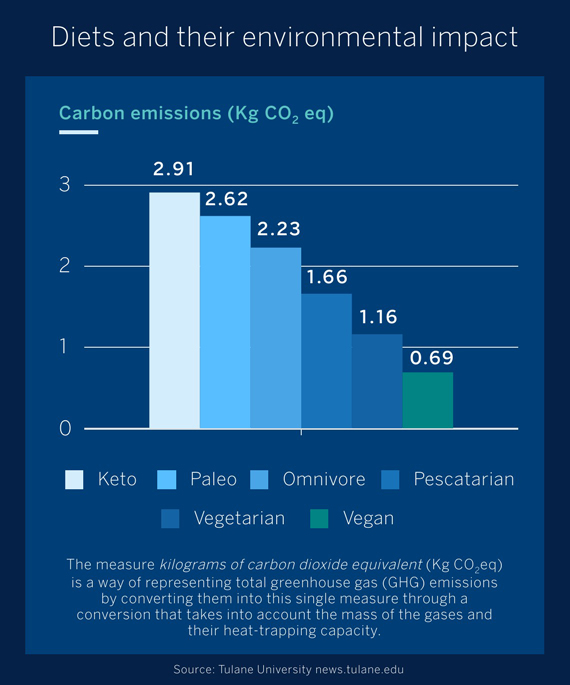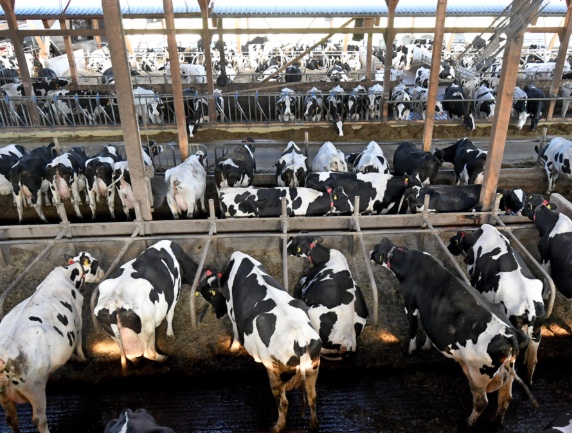The effects of climate change are now well known and evident. As a result, more and more people are becoming aware of the need to take action, not only at a global scale, but also at an individual level by recycling, reducing waste production, opting for second-hand products, travelling by public transport or bicycle, buying local products… And also adopting a more sustainable diet—without compromising one’s health.

This decision is far more important than you might think, because, as Gregory Keoleian, director of the Center for Sustainable Systems at the University of Michigan, says, “consumers have the greatest influence in reducing carbon emissions from the food system by changing their diets to lower carbon-intensive food.” This decision can also have a multiplier effect, as consumer choices influence producers. In other words, as more and more people choose certain types of food and reduce their consumption of others, this trend will eventually be reflected in production on a global scale.
The study
A recent study by US researchers analysed the carbon footprint of the main diets or eating habits followed in the United States—which can be extrapolated to the whole of the First World.
The six diets analysed were: vegan, (lacto-ovo) vegetarian, pescetarian, keto, paleo and omnivore. The results show that in terms of carbon footprint, expressed as CO2 equivalent (CO2eq), the vegan diet generates 0.69 kg of CO2eq/1000 Kcal; the vegetarian diet 1.16 kg CO2eq/1000 Kcal; the pescetarian diet 1.66 kg CO2eq/1000 Kcal; the omnivore diet 2.23 kg CO2eq/1000 Kcal; the paleo diet 2.62 kg CO2eq/1000 Kcal and the keto diet 2.91 kg CO2-eq/1000 Kcal.

In other words, the highest-emitting diets—paleo and keto—produce, respectively, three and four times more greenhouse gases than vegan diets, and almost twice as much as the pescetarian diet.
Food
Our diet—everything involved in producing, processing, transporting and disposing of the food we eat—generates more than a third of the planet’s total greenhouse gas emissions.

Food-related emissions can be divided into four broad categories:
- Those from land use, understood as agriculture and livestock farming, but also the various associated land disturbances and activities: deforestation, water pumping and transport, etc.
- Those generated by the consumption of energy to produce, process, package and transport food.
- Industrial emissions resulting from the production of various chemical compounds: plastics for packaging, preservatives, fertilisers, insecticides, fertilisers, etc.
- Emissions related to the treatment of waste and surpluses.
Of these, the first category—land use—is the largest contributor, accounting for 20% of the planet’s total emissions. However, the other three sources of emissions together account for a further 20%.
Keto or ketogenic diet
The keto diet generates the largest carbon footprint due to its high protein and fat intake and very low carbohydrate consumption. These proteins are mainly of animal origin, as the main plant protein sources (legumes, nuts) also provide a significant amount of carbohydrates.

Foods derived from land animals—and within these, meat, especially from ruminants—are by far the largest contributors to the carbon footprint of the diet, far more than cereals and pulses. This is quite easy (and intuitive) to understand when we look at the food chain. When we eat plant products, we are primary consumers. However, when we eat animal products, we are secondary consumers. In other words, there is an intermediate stage. And that means that all the carbon emitting processes are duplicated. For example, growing potatoes requires the use of land and the consumption of water. But producing meat requires the use of land and water to produce the fodder to feed the cattle, plus the consumption of the livestock farms themselves (and the very significant methane emissions in the form of flatulence from the cattle). The same applies to the necessary chemicals, the transport and processing, and the treatment of waste.
Paleo diet
The paleo diet has the second highest climate impact. Again, this is because it is another diet characterised by the consumption of mainly land-based meat, as it is believed that our Paleolithic ancestors preferred hunting to fishing, although recent evidence is beginning to challenge this belief; and also because this diet restricts the intake of many plant-based products. In addition to land-based meats, the paleo diet allows the consumption of eggs, fish and seafood, nuts, fruits, seeds and some vegetables—but not those high in starch—while excluding cereals, legumes, dairy products, sugary vegetables and all types of processed foods.
This explains the significant impact of the paleo diet, as it has been estimated that if the US eliminated 90% of its beef and 50% of its animal-based food consumption and replaced it with plant-based foods, it would prevent more than 2 billion tonnes of greenhouse gas emissions from being released into the atmosphere by 2030. To put this in context, it is the equivalent of taking half the cars on the planet off the road for a year. And the US population, currently estimated at 336 million people, represents only 4% of the world’s population and 25% of the population of the First World, where more animal-based foods are consumed and where there are dietary choices.

A very revealing fact in this context is that China’s food-related emissions increased by 50% between 1990 and 2018, due to an increase in meat consumption from 30 grams per person per day in 1980 to 150 grams per person per day in 2010, as a result of the westernisation—or globalisation—of the Chinese population’s diet over this period.
Pescetarian diet
The pescetarian diet, characterised by the fact that its adherents only consume meat of marine origin (fish, shellfish, molluscs, etc.), is the third least polluting diet. Due to the fermentative nature of their digestive process, ruminant mammals release an enormous amount of methane—a gas with a greenhouse effect 28 times more potent than CO2—as well as requiring large amounts of water and land, so they have a significantly larger carbon footprint than pigs and poultry.

Seafood, on the other hand, has a lower carbon impact than any of the above. This is especially true if you choose to eat shellfish and small fish such as anchovies, sardines, etc., and other inshore and coastal species caught by local rather than deep-sea fishermen, which avoids emissions from transport and from preserving the catch during the journey. Aquaculture fish, such as salmon and gilt-head bream, or farmed crustaceans, require feed in the form of food pellets and oil, and therefore release much more waste and emissions into the environment. Bivalve molluscs are also one of the least environmentally damaging sources of food, as they have minimal requirements for their cultivation or farming due to their nature as sessile, filter-feeding organisms that obtain their food by filtering the water.
Vegan diet
The vegan diet has the smallest carbon footprint, according to the study. This makes sense when you consider that animal-derived foods—red meat, poultry, fish and seafood, eggs, dairy and animal fats—account for 82% of the carbon footprint associated with food, so replacing them with plant-based sources of protein and fat, such as legumes, nuts and seeds, would dramatically reduce the environmental impact. In fact, it has been estimated that if animal-based foods were completely eliminated and replaced with plant-based foods, dietary-related emissions would be reduced by more than 73%.

In addition, more than 30% of the Earth’s land surface is used for pasture and fodder crops, which has a huge impact on biodiversity and deforestation, resulting in the loss of forest cover capable of absorbing carbon dioxide from the atmosphere. If these areas were replanted with a variety of plants, the area of vegetation would increase, leading to a huge amount of CO2 being sequestered from the atmosphere through respiration, in the order of hundreds of gigatonnes.
Lacto-ovo vegetarian diet
The diet with the second smallest carbon footprint is the lacto-ovo vegetarian diet. Unlike the vegan diet, it allows the consumption of eggs, milk and their derivatives, which explains its greater impact: the dairy sector alone is responsible for 4% of global greenhouse gas emissions. This percentage rises to 37% for methane emissions—a greenhouse gas 28 times more potent than CO2—and requires a large amount of water and land.

Nevertheless, this diet is still a carbon-friendly choice; applying the data from the study, if an omnivore chose to eat only vegetarian dinners—without giving up the highest quality animal protein, that obtained from eggs and dairy products—their weekly carbon footprint would be reduced by around 7.7 kg CO2eq. Over the course of a year, this adds up to about 385 kg of CO2eq, which is already a significant amount considering that the total annual carbon footprint of a person living in a First World country like Spain is about 5 T of CO2eq. On an individual basis, this may seem like a rather small contribution to the cause, but it is not so small if we multiply these 385 kg of CO2eq (or 0.385 T) by the 1.3 billion inhabitants of the First World, which comes to around 520 million T, where the total emissions attributable to food production are estimated to be around 12 billion T of CO2eq per year.
Omnivore diet
This is the diet followed by those people who do not identify with any of the other diets, i.e., the vast majority of the population—up to 86% in the case of the United States. The omnivore diet has the third largest carbon footprint. However, there are nuances to both statements, as the study is limited to the US population, which is characterised by a high consumption of beef.

It has been estimated that producing the amount of meat consumed annually by a US citizen generates more than 2,000 kilograms of greenhouse gases per year. Eliminating meat consumption one day a week would reduce this amount to 1,600 kilograms. And if two out of every three meals were free of animal products, the volume of emissions would fall to less than 740 kilograms. This would be considerably less if the meat, instead of being land-based, were of marine origin, especially small fish or molluscs, which do not require the use of land, the production of fertilisers, insecticides or medicines and do not produce flatulence.
Another study, this one carried out in the European Union, has concluded that halving the consumption of meat, dairy products and eggs would reduce food-related greenhouse gas emissions by almost 40%.
Miguel Barral
Comments on this publication